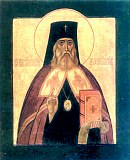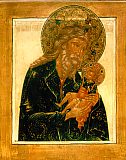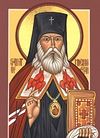

| Previous day | Next day |
| Old Style
February 3
|
Tuesday |
New Style
February 16
|
| 37th Week after Pentecost. Tone 3. | No fast.
|
![]() Afterfeast of the Meeting of Our Lord.
Afterfeast of the Meeting of Our Lord. ![]() Holy and Righteous Symeon the God-receiver and Anna the Prophetess (1st c.).
Holy and Righteous Symeon the God-receiver and Anna the Prophetess (1st c.). ![]() St. Nicholas, Equal-to-the-Apostles, enlightener of Japan (1912).
St. Nicholas, Equal-to-the-Apostles, enlightener of Japan (1912).
Prophet Azariah (10th c. в до Р.10th c..). Martyrs Papias, Diodorus, and Claudianus, at Perge in Pamphylia (250). Martyr Blaise of Caesarea in Cappadocia (3rd c.). Martyrs Adrian and Eubulus, at Caesarea in Cappadocia (ca. 308-309). St. Romanus, prince of Uglich (1285). St. Symeon, bishop of Polotsk and Tver (1289). St. Svyatoslav-Gabriel and his son St. Dimitry, of Yuriev (1253). St. Ignatius of Mariupol in Crimea, metropolitan of Gothia and Kafa (1786).
New Hieromartyrs Vladimir (Zagreba), hieromonk of Borisoglebsk Monastery (Novotorzhok), Basil Zalessky, archpriest, of Astrakhan, and Adrian Troitsky, archpriest, of Kazan (1938).
Martyr Paul the Syrian (284-305). St. Lawrence, archbishop of Canterbury (619). St. Werburga of Chester, abbess (ca. 700). St. Ansgar, bishop of Hamburg, enlightener of Denmark and Sweden (865). St. James, archbishop of Serbia (1292). St. Sabbas of Ioannina (15th c.). New Martyrs Stamatius and John, brothers, and Nicholas, their companion, at Spetses on Chios (1822).
Repose of Schemamonk Paul of Simonov Monastery (1825), disciple of St. Paisius (Velichkovsky), and Hieromonk Isidore of Gethsemane Skete, Moscow (1908).
Thoughts for Each Day of the Year
According to the Daily Church Readings from the Word of God
By St. Theophan the Recluse

Monday (33rd). [I Pet. 2:21–3:9; Mark 12:13–17]
The Apostle now points out to us the hidden man of the heart (I Pet. 3:4) as the object of our most careful concern and care. We are to adorn ourselves through the formation of this man within ourselves. What is this hidden man of the heart? It is that man which forms in the heart when only good dispositions and feelings come to dwell therein. Examine these dispositions and feelings, and you will see the face of the man hidden in the heart. Here are those dispositions! As His divine power hath given unto us all things that pertain unto life and godliness (II Pet. 1:3), and on your part, giving all diligence, writes Saint Peter, add to your faith virtue; and to virtue knowledge; and to knowledge temperance; and to temperance patience; and to patience godliness; and to godliness brotherly kindness; and to brotherly kindness love (II Pet. 1:5–7). In a similar fashion Saint Paul lists the inner good dispositions of the Christian heart: The fruit of the Spirit is love, joy, peace, longsuffering, gentleness, goodness, faith, meekness, temperance (Gal. 5:22–23). Also: Put on therefore, as the elect of God, holy and beloved, bowels of mercies, kindness, humbleness of mind, meekness, longsuffering ... and above all these things put on love, which is the bond of perfectness. And let the peace of God rule in your hearts (Col. 3:12–15). Bring together all of these goods into one spiritual body with its various members, and you will see the divinely beautiful face of the hidden man of the heart. You must fervently establish the same in your own heart.
Tuesday. [I Pet. 3:10–22; Mark 12:18–27]
But sanctify the Lord God in your hearts (I Pet. 3:15). Sanctifying the Lord in one’s heart is the soul and spirit of the hidden man of the heart depicted above. As in the beginning, God created the body of man out of particles of dust, breathed into him the breath of life (cf. Gen. 2:7), and man became as he ought to be, so the hidden man of the heart, created on the inside from the indicated virtues, is only a real spiritual man when his heart sanctifies the Lord God. Thus, we read in the Lord’s Prayer, “Hallowed[1] Be Thy Name.” If this does not occur, then the man, who was modelled from the aforementioned virtues, will end up a stillborn child, without the spirit of life. Let this be known to those who think to get away with a few virtues without having any relationship to God! What does it mean to sanctify God in the heart? It means showing great reverence before Him unceasingly, always bearing in mind the thought of His omnipresence; being eager at every instant to zealously please Him, and with all fear to beware of everything unpleasing to Him. Especially, it means committing all of your temporal and eternal life unto His fatherly care; to accept all that happens humbly, submissively and thankfully, as coming straight from His hand.
[1]In the Slavonic, the words “sanctify” from the Epistle is the same as word as “hallowed” in the Lord’s prayer.
Articles
 Prophet AzariahThe name Azariah means “whom God helps.” The holy prophet lived during King Asa’s reign (2 Chron. 15:1). |
 Martyrs Papias, Diodorus, and Claudianus, at Perge in PamphyliaSaint Papias was martyred with Saint Claudianus at Perge, Pamphylia in 250. |
 Martyr Blaise of Caesarea, in CappadociaSaint Blaise of Caesarea lived in the third century. He was from Caesarea in Cappadocia (Asia Minor) and was a shepherd. |
 Martyr Adrian at Caesarea, CappadociaSaint Adrian of Baneas of Caesarea in Cappadocia. suffered martyrdom under Governor Firmilianus. |
 Martyr Eubulus at Caesarea, CappadociaSaint Eubulus, like Saint Adrian, was from Baneas, in Caesarea of Cappadocia. |
 St. Simeon the Bishop of Polotsk and TverSaint Simeon, Bishop of Tver was descended from the Polotsk princes. He was the seventh bishop of Polotsk and the first bishop of the Tver diocese. |






